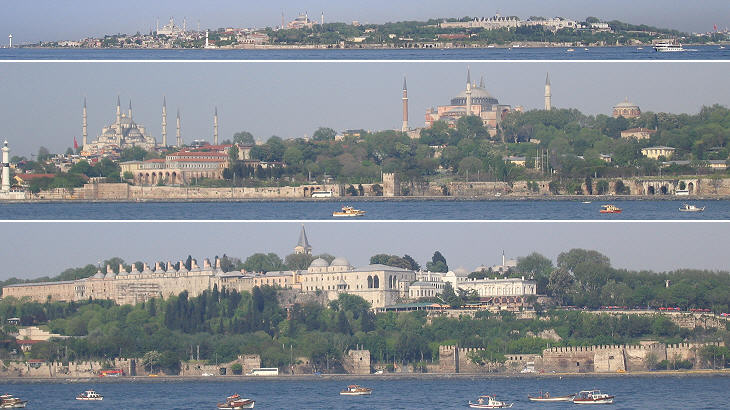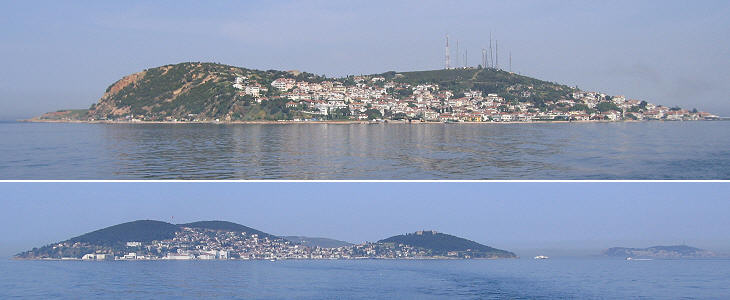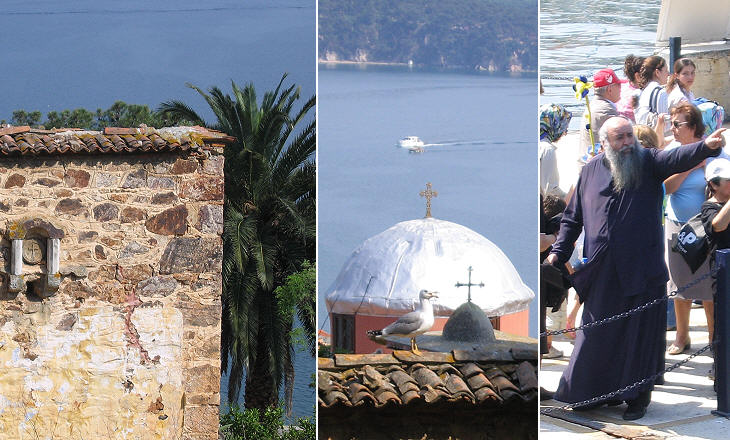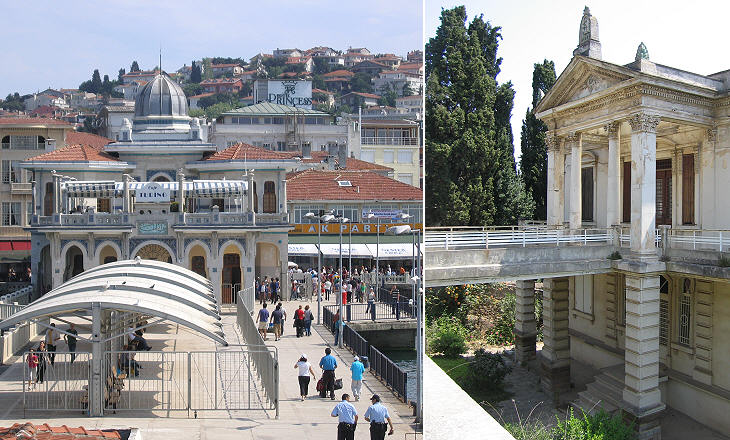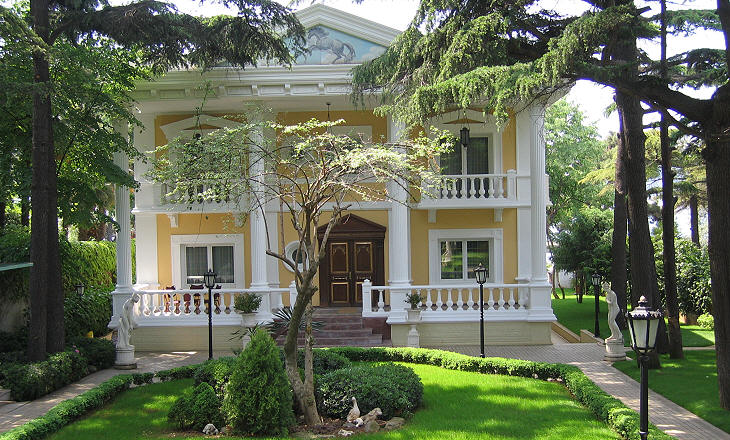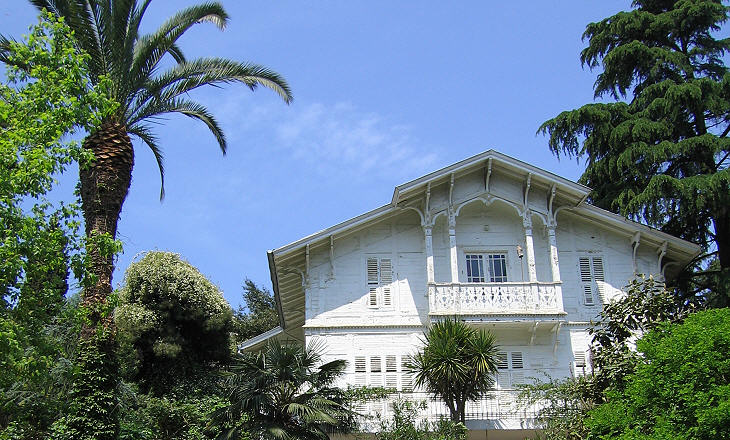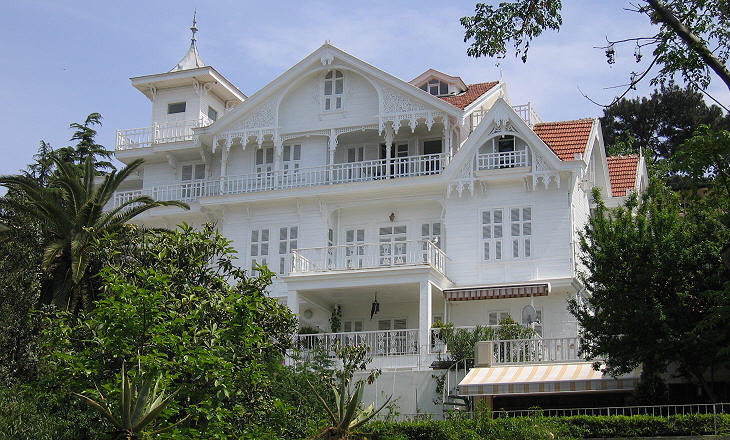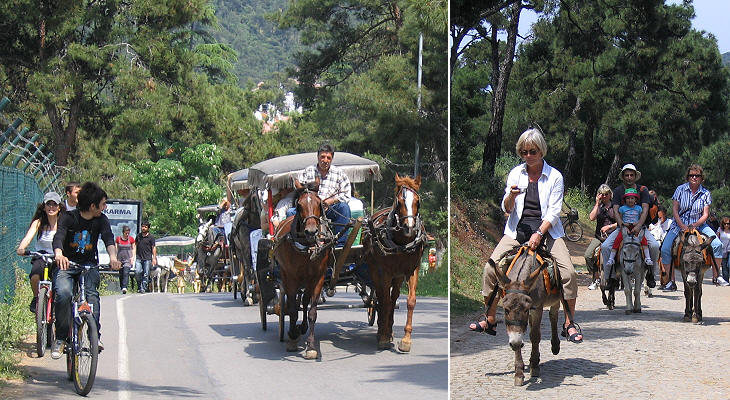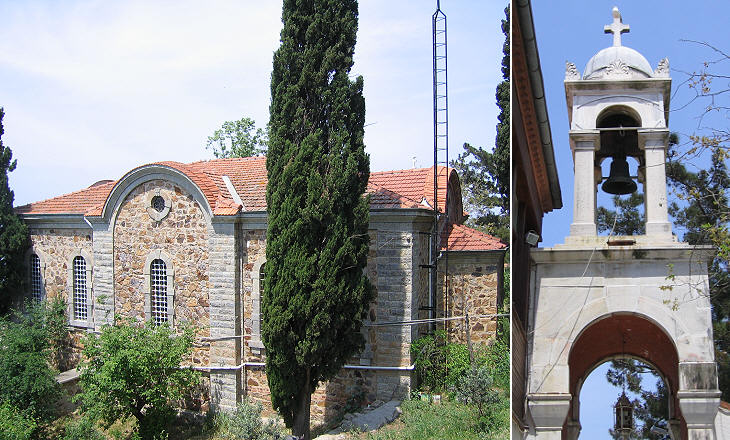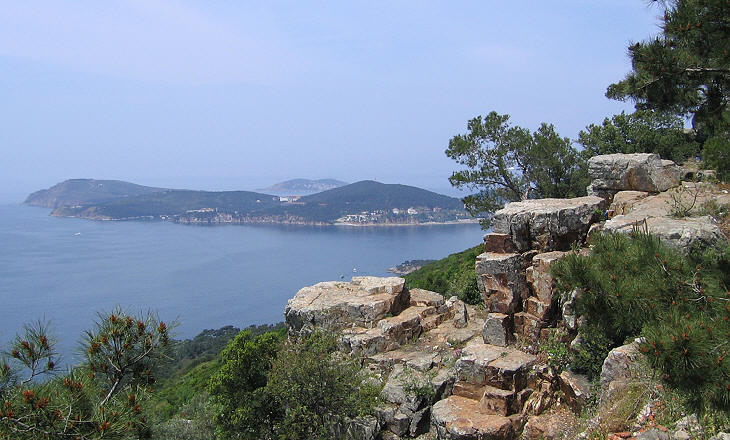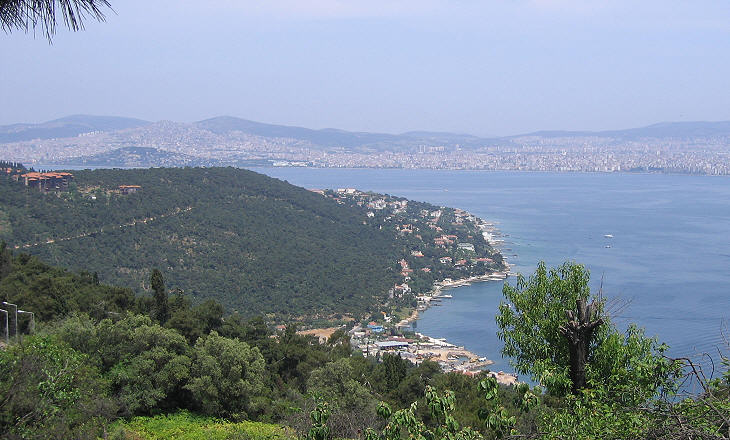  What's New! Detailed Sitemap All images © by Roberto Piperno, owner of the domain. Write to romapip@quipo.it. Text edited by Rosamie Moore. Page revised in August 2015. |
 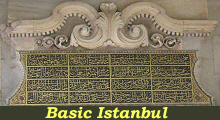 The Princes' Islands The Princes' Islands
You may wish to see an introduction to this section first. A virtual tour of Basic Istanbul must include two excursions to its environs: the Bosporus and the Princes' islands. The former can be done via pages dedicated to fortresses located along this strait (Anadolu Hisar, Rumeli Hisar and Anadolu Kavagi), the latter is covered in this page.
On a morning ferry to the islands it is difficult to stay in the front of the boat, because the view towards the city is magnificent. Mark Twain, who visited Constantinople in 1867, wrote in The Innocents Abroad: We dropped anchor in the mouth of the Golden Horn at daylight in the morning. (..) Seen from the anchorage, it is by far the handsomest city we have seen. Lady Mary Wortley Montagu (1689-1762) spent two years in Constantinople where her husband was English Ambassador to the Ottoman Empire; in a letter to a friend which she wrote while returning home she described Genoa: Genoa is situated in a very fine bay; and being built on a rising hill, mixed with gardens, and beautified with the most excellent architecture, gives a very fine prospect off at sea; though it lost much of its beauty in my eyes, having been accustomed to that of Constantinople.
The Princes' Islands are a group of nine small islands which are located to the east of Istanbul, near the Asian coast of the Marmara Sea. Four islands are populated: they all have a Greek and a Turkish name (the suffix ada means island). The largest island is Prinkipo, which gives the name to the small archipelago; Buyukada, its Turkish name, means big island. Samuel Sullivan Cox (1824-89) was an American Congressman who was appointed Ambassador to the Ottoman Empire in 1885. He wrote The Pleasures of Prinkipo, a book on a summer spent in these islands which he described as follows: These Isles of the Princes lie in sight of Stamboul and its splendors, and of the mountains of Asia, dominated by the Mysean Olympus. They are glorious in physical loveliness. They are still the "Isles of Greece," although under Ottoman rule. Out of their blue waters, at morn and eve, the beauty of the Grecian myth arises, to grace the isles with her smiles. Upon them burn "the larger constellations". They are fitly named "Isles of Princes". Upon them the palaces of the princes of old Byzantium were erected. Here, too, were their monasteries and prisons. The relics of these lines of civil and ecclesiastical empire are nearly all faded; but the monasteries of the Orthodox Greek Church still hold here their eminences, as well by virtue of their antique titles as by their superb situations. Nowadays Proti (The first)/Kinaliada suffers from being the island which is nearest to Istanbul: too many modern houses have been built for wealthy commuters and too many telecommunication aerials have been placed on its highest hill.
It is said that the prevalent Greek population of the islands at the end of the XIXth century is due to the fact that Sultan Mehmet II, the conqueror of Constantinople, allowed the Greeks of the city who so wished to relocate to these islands. As we know that in the following centuries the islands were very scarcely populated, their Greek aspect at the end of the XIXth century was due to the fact that they were chosen as a summer retreat by wealthy Greek (and Armenian) families. Antigoni owes its name to Antigonus I Monophtalmus (one-eyed), a general of Alexander the Great and the founder of a personal kingdom after Alexander's death. The Turkish name is a reference to the tower of a monastery which stood for centuries on a hill of the island: burgaz is a Turkish word derived from Greek pyrgo which means tower.
Chalki owes its name to its historical copper (Gr. khalkos) mines. The emperors of Constantinople retained possession of the islands until the very end of their rule and Chalki most likely has the last monastery/church built by a Byzantine empress, Maria Comnena wife of Emperor John VIII Palaeologos and daughter of Emperor Alexios IV of Trebizond. Unfortunately in 1942 the site was confiscated and included in the premises of the Turkish Navy Academy (see it in this external link).
Chalki retains several modest yet charming wooden houses.
Samuel Cox described with these words the town of Prinkipo: Upon the north-western side of Prinkipo there is a little city whose villas are rare in elegance and architecture, whose gardens have a hesperidean fruitage and bloom, and whose red-tiled roofs over the white or yellow buildings add a refinement to the town and isle which the bath houses at the water's edge, upon the jutting crags, themselves ornamental, in vain try to dispel. The rich Greek merchants and bankers, together with the English, German, French, American, Armenian and Swiss families, who summer here, have not only spent their money freely to decorate their own homes and grounds, but they have made winding roads, up hill and down, which cross and encircle the island.
According to Samuel Cox the modern development of Prinkipo was due to the skill of a Maltese entrepreneur: The people disappeared and the isle became a waste, remaining thus until only a few short years ago. It was a mountain of pine trees in a land denuded of other vegetation. Like all such places, it had to have a pioneer. Out of his enterprise, within a half century, Prinkipo has become a second garden of Eden. His name will be perpetuated, for the first hotel of the island is named after him, though it is located back and above that of Signora Calypso, of the Homeric epic. Signor Giacomo started early here. He kept goats and loved America. He was a Maltese. That means that he was more or less of a mixed race. Doubtless he was mostly Italian. He was a devout Catholic. He came to these waters of the East a little ragged sailor. He was employed at a store in Galata. There is a Maltese street there yet, and through its fragrant purlieu I often ride, but seldom walk. I hurriedly go through this rueful rue, where Limburger cheese exchanges its odor with herring, and onions help to dilate the nostril. After Giacomo's successes at Galata, he came here and constructed houses around his own larger house, and upon terraced plateaux that rose in loveliness to the mountain top. He decorated his terraces with a profusion of his favorite white roses, whose fragrance was wafted far out at sea; thus in some manner, as it were, compensating in his opulent days for the infragrance of his work in the time of youthful poverty. What forty years ago was "Giacomo's Delight" is now everybody's delight.
The islands were used by Byzantine emperors as a location where they exiled their enemies, who very often were their predecessors. Some of them were forced to become monks, but in order to ensure they could not pose a threat their eyes were gouged out and their sons were castrated. Samuel Cox was fascinated by the history of Empress Irene, who ruled the empire as regent (780-97) and as monarch (797-802). Upon this stage moves Leo IV, son of the fifth Constantine. This Emperor Leo took an Athenian orphan girl to wife. She had great personal accomplishments. He was feeble; she was not. It is the old story; she was the ruler of the Emperor, and at his death, by his will became Empress-Guardian of all the Eastern Empire. After many trials the Prince succeeded in obtaining the throne and humiliating his mother, but he was soon dethroned by a counterplot of the wily Irene. She had his eyes put out. She had him assassinated. The great treasurer, Nicephorus, led the conspiracy. He was secretly invested with the purple and crowned in St. Sophia. Irene sought a retreat from her perfidious treasurer. This, her prayer, was granted; but when she requested her treasures, they were refused her; for was he not a good treasurer? But he graciously allowed her to retire honorably to the monastery of Prinkipo. It seems that this was too near Byzantium for his comfort, for he banished her to the Island of Lesbos. There, like good Penelope, she endeavored to atone for her unnatural crimes by a life of labor at the distaff. With this simple implement the empress, who had revelled in all the splendors of the Blachernal palace, was enabled to earn a scanty subsistence.
In modern times Prinkipo was the exile location of Leon Trotsky, the Russian revolutionary leader, who was expelled from the Soviet Union in 1929. He stayed in the island for four years. Esteban Volkov, grandson of Leon Trotsky, in 2002 returned to the place where his grandfather had lived after his expulsion: Then I took the boat to Prinkipo, where they lived from April onwards. The island has changed a lot since my childhood, of course. But it is still a very beautiful place, just as it always remained in my memories of those times.
The best way to tour the island is by foot; there are however other interesting alternatives, but cars are not allowed.
No civilized visitor misses the opportunity to walk to the monastery of St. George's at the top of one of the two peaks of the island. Samuel Cox was told about a legend explaining its foundation: The legend goes, that many years ago, a shepherd tending his flock on the summit, where the monastery stands now, went to sleep one hot afternoon. In his sleep he has a dream. In the dream he is advised to dig in a certain spot close to where he is lying and "he would hear of something to his advantage." He digs and finds a horseman mounted on a beautiful white charger, with bells hung round the animal's neck. The horseman makes a behest to the sleeping shepherd. He is enjoined to dig again, according to directions. He digs and finds an old picture. It represents exactly the horseman whom he had seen in his dream, even to the bells round the horse's neck. A superstitious importance is attached to the discovery. This is strengthened by the fact that the shepherd, who previously was quite an imbecile, the moment he touches the picture becomes possessed of the most extraordinary knowledge in all matters. The picture is recognized. It represents St. George.
The monastery is modern although it was built on top of a previous Xth century building. Two different processions walk along the steep path which leads to the monastery: the joyful tribe of tourists who stop every so often to take pictures, drink and relax and the tribe of those who focus on reaching the monastery by a steady pace leaving behind them a long uninterrupted thread; they do not talk to anyone, they are absorbed in their thoughts; they come to accomplish a vow they made or to ask for the help of God for one of their relatives: it is a sort of Scala Santa. It is a holy place for all religions.
Introduction to this section Roman Memories Hagia Sophia Hagia Irene and Little Hagia Sophia Byzantine Heritage - Other Churches (before 1204) Roman/Byzantine exhibits at the Archaeological Museum Great Palace Mosaic Museum St. Saviour in Chora Byzantine Heritage (after 1204) First Ottoman Buildings The Golden Century: I - from Sultan Selim to Sinan's Early Works The Golden Century: II - The Age of Suleyman The Golden Century: III - Suleymaniye Kulliye The Golden Century: IV - Sinan's Last Works The Heirs of Sinan Towards the Tulip Era Baroque Istanbul The End of the Ottoman Empire Topkapi Sarayi Museums near Topkapi Sarayi Map of Istanbul Other sections dealing with Constantinople/Istanbul: The Walls of Nova Roma Galata Clickable Map of Turkey showing all the locations covered in this website (opens in another window). |
